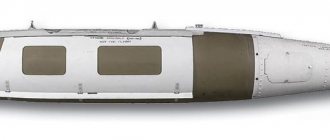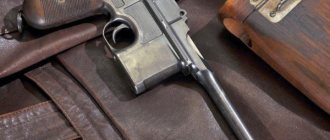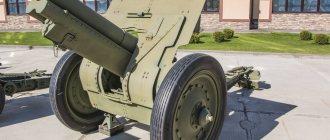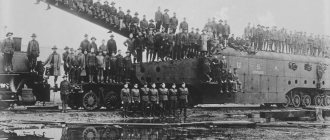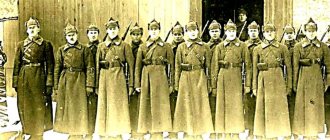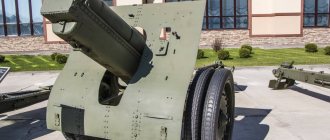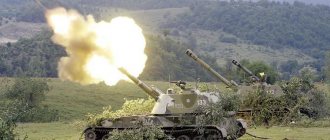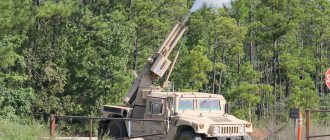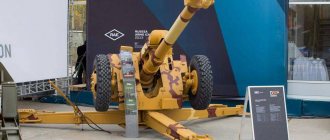The entire history of mankind is a history of wars mixed with short-term peace. Despite the fact that the volleys of the bloodiest conflicts died down in the 20th century, the need for weapons to protect and promote geopolitical interests has not disappeared to this day. All developed and many developing countries are striving to increase their defense capabilities. An illustrative example is the United States, which spends enormous sums on the military-industrial complex. A large portion of defense spending goes to the development of US artillery.
United States military power
In 2022, the United States has allocated a significant portion of its budget—15%—to military spending. $565 billion was spent on defense, which amounted to 3.1% in relation to the state’s GDP. In 2022, the amount of funds spent on military spending exceeded the previous year and amounted to almost $700 billion. Part of the funds in the amount of 60 billion was allocated to combat operations in the Middle East. However, much larger sums were poured into the modernization of weapons and innovative developments in the military-industrial complex.
The United States currently has the most powerful army in the world. It has all kinds of equipment at its disposal - from artillery and missile systems to heavy drones, armored vehicles, warships and aircraft. The United States has a particularly large air force. The total number of military personnel is about 2 million people. The success of ground operations is guaranteed by the artillery of the US Army. It includes mortars, MLRS, towed artillery and self-propelled artillery mounts.
Keep throwing
“We have increased the range of our artillery at the Yuma Proving Ground,” said U.S. Army General D. Murray, who leads the U.S. Army's weapons design, development and development office.
Not so long ago, M777-type howitzers or other artillery systems could hit targets only at a distance of about 30 km. The increase in range can be called a major shift in strengthening the offensive capabilities of the American army.
General Murray does not hide the fact that the main goal of the work carried out by his unit remains to gain a tactical advantage over the Russian Federation and China. In his speech, he also recalled the Russian invasion of Ukrainian territory. He said this was a wake-up call for the US military. Murray said that the US Army command was concerned about the weapons and tactics used by the modern Russian army.
“In Ukraine, we saw the interaction of unmanned aircraft with artillery. UAVs were used as gunners. The updated Russian organizational structure and tactics were a wake-up call for us. Therefore, we began to look for a more serious strategy,” said the American general.
The US military's strategy is changing as Russia uses its new weapons and armored vehicles in Ukraine.
“Russia is using new and modernized types of tanks and other armored vehicles against Ukraine. Many of these models use 125 mm projectiles in conjunction with anti-tank and anti-helicopter missiles at ranges of up to 6 km. The Russian Armed Forces have modern armored vehicle protection systems, which include active armor and other means,” the strategy says.
Artillery during the Civil War
The American Civil War arose from the conflicting socio-economic systems of the north and south of the country, in which the north opposed slavery, and in the south it was historically entrenched. The war began in 1861 and ended in 1865 with the defeat of the southerners. Americans lost more people in it than in any other war in the history of the United States.
Field artillery in the United States was actively used on both sides. Its main task was to support the army (infantry and cavalry) during the battle. Both sides had two types of artillery - smooth-bore and rifled-bore. From the first, guns and howitzers stand out. They were made either from bronze or iron. Less often - made of steel. The shells fired by smoothbore guns and howitzers varied in weight and caliber. Large shells were more typical for cannons. Of these, at the beginning of the war, the “six-pound gun” was considered the most popular, but due to its low range (about 1300 meters), by the middle of the war it was replaced by twelve-pound guns.
Rifled artillery is considered more complex and expensive to produce, but at the same time has an increased firing range. It allowed for more accurate shooting over much longer distances. The most popular rifled guns were the three-inch and Parrot guns. The first was distinguished not only by high shooting accuracy, but also by durability - during all the wars in which the three-inch gun took part, the fact of a barrel rupture was recorded only a few times. The Parrott gun was also used by both sides of the conflict, mainly the 10 and 20 pounder. They weighed quite a lot (more than 800 kg), and it was not always possible to find 2.9 caliber ammunition for them.
Westervelt Commission
By the beginning of the First World War, the United States had a rather modest army by European standards. A sharp increase in its numbers in 1917-1918. accompanied by a corresponding deployment of artillery units. They were armed mainly with French-designed guns - the famous 75-mm field guns, as well as (in much smaller quantities) heavier systems. To summarize the experience of the combat use of artillery and develop recommendations for the further development of artillery weapons, on December 11, 1918, the Chief of Staff of the US Army, General P.S. March ordered the creation of a commission of seven generals and officers, officially called the Caliber Commission, but more often called the Westervelt Commission, after the brigadier general who headed it. On January 12, 1919, the commission began work in France, subsequently visiting Italy and Great Britain. Members of the commission familiarized themselves with the preliminary conclusions of the allied headquarters regarding the combat use of artillery and visited combat units and weapons factories. On May 5, 1919, the commission presented a 38-page report that essentially determined the development path of American artillery for the next two decades. Note that the chairman of the commission, General Westervelt, subsequently headed the Army headquarters, and one of the commission members, Walter Boatwright, became the chief of artillery.
Prototype 105-mm howitzer M1920
The conclusions of the Caliber Commission concerned almost all types of artillery, but we will touch only on those that related to the prospects for the development of light field guns. On the one hand, the commission confirmed the conclusion made back in 1916 by the American military agent in France, Colonel Charles Summerall, about the advisability of moving at the divisional level from 75-76 mm guns to 100-105 mm howitzers, more suitable for trench warfare. On the other hand, the commission did not consider it possible to completely abandon light guns. As a result, it was proposed to develop both classes of guns in parallel.
The light field howitzer was seen by the commission members as a weapon of about 105 mm caliber, firing shells weighing 30-35 pounds (13.62-15.89 kg) at a range of up to 12,000 yards (10,980 m). The vertical aiming angle was supposed to be from - 5° to + 65° - in principle, nothing unusual. But what was fundamentally new was the desire to provide circular horizontal fire. Semi-unitary loading and the use of variable charges were provided. The basis of the ammunition was to be high-explosive fragmentation shells, and the use of shrapnel was also envisaged.
The light gun was supposed to have a caliber of about three inches (76.2 mm). Its design was to be based on the principle of versatility - the use of a gun not only as a field weapon, but also as an anti-aircraft one. Therefore, the vertical aiming angle was determined in the range from - 5° to + 80°. Just like for the howitzer, it was necessary to ensure circular horizontal fire. To achieve a high rate of fire (up to 20 rounds/min), unitary cartridges should be used. At the same time, a recommendation was made to produce cartridges with two different charges - normal for shooting at a range of up to 11,000 yards (10,065 m) and reinforced - for a longer range. The weight of the projectile was not to exceed 20 pounds (9.08 kg). The gun's ammunition should have included a grenade, as well as shrapnel with a temporary fuse.
105 mm M2 howitzer on an M1 carriage. Such howitzers were produced in the early 30s
The idea of creating a universal cannon, so popular in many countries in the 20-30s. last century, has found some development in the United States. In the first half of the 30s. The US military was testing a 75 mm light divisional gun, which was more of an anti-aircraft gun adapted for use as a field gun than a field gun with the ability to fire at air targets. The pedestal installation of the gun was mounted on a carriage with sliding frames. To ensure all-round firing there was an attached third frame. The elevation angle reached 85°. But the matter did not progress beyond testing - the idea of a universal weapon in the USA (as well as in the USSR) confirmed its depravity.
American artillery of World War II
US artillery, more than 80 years after the Civil War, had changed greatly by the time of World War II. Due to the conduct of battles on land, in the air and on water, as well as due to the emergence of new military equipment, naval guns, anti-aircraft guns, and anti-tank guns began to be included in the artillery.
The main US naval gun during World War II was the 12″/50 Mark 8. First tested in 1942, it was not installed on two battlecruisers until 1944. The gun could fire at a distance of 35 km, 2-3 shells per minute. The projectile was extremely heavy - from 426 to 517 kg, and the gun itself weighed more than 55 thousand kg. Among the anti-aircraft guns used against enemy aircraft, the 37-mm M1 cannon can be distinguished. Until 1942, it was the only model in the ranks of anti-aircraft artillery. The sighting range of this gun was 3200 meters, and the projectile speed reached almost 800 meters per second. A little later, the M1 cannon was replaced by the more advanced Swedish Bofors gun. There is a 120 mm version of the M1 gun. She only managed to take part in the Korean War, where she carried out anti-battery fire.
US artillery during World War II had a large variety of anti-tank guns. At first, the 37-mm M3 cannon took part in the battles, which, closer to 1944, was replaced by the 57-mm M1 cannon of the English model due to the impossibility of penetrating the improved armor protection of German military equipment. Until the end of the war, the US Army used the 3-inch M5 gun. It could penetrate armor protection up to 9 cm thick, but its enormous mass and clumsiness forced the American army to adopt more mobile guns. As for howitzers, M101, M115, M116 were used to support American infantry. After the end of World War II, many of them participated in the Vietnam campaign, and the M115 and M116 are still in service in some countries around the world.
American standard
“It takes a long time to harness, but it goes fast” - perhaps this is the saying that best characterizes the history of the creation of the main weapon of American field artillery during the Second World War. Long development culminated in the creation of the 105-mm M2A1 howitzer, a very successful artillery system that survived the entire war and was produced until 1983.
The long road to a new howitzer
By the end of World War I, the bulk of American artillery was made up of French-designed guns - the famous 75 mm field guns, as well as (in much smaller quantities) heavier systems. The battles in Europe had barely died down when on December 11, 1918, by order of the Chief of Staff of the US Army, the Caliber Commission (better known as the Westervelt Commission, named after the brigadier general who headed it) was created, whose task was to develop recommendations for the further development of artillery weapons. On May 5, 1919, the commission presented a report that determined the development of American artillery for the next two decades.
The conclusions of the Caliber Commission covered almost all types of artillery, but we will consider only those that related to light field guns. On the one hand, the commission confirmed the conclusion made back in 1916 by the American military agent in France, Colonel C. Summerall, about the advisability of moving at the divisional level from 75–76 mm guns to 100–105 mm howitzers, more suitable for trench warfare. On the other hand, the commission did not consider it possible to completely abandon light guns. As a result, it was proposed to develop both classes of guns in parallel.
As envisioned by the commission members, a light field howitzer should have a caliber of about 105 mm, a projectile weight of 30–35 pounds (13.62–15.89 kg) and a firing range of up to 12,000 yards (10,980 m). The elevation angle was supposed to be 65°, which would allow mortar fire. A circular horizontal shelling was desirable. True, this idea was almost immediately abandoned due to the complication of the carriage design. The gun was supposed to have semi-unitary loading, the main type of projectile was high-explosive fragmentation, and the auxiliary type was shrapnel.
The light gun was supposed to have a caliber of about three inches (76.2 mm). It was proposed to base its design on the principle of universality - the use of a gun as not only a field weapon, but also an anti-aircraft one. However, after testing several prototypes, the American military realized that nothing good would come of it, and the idea was abandoned, limiting itself to modernizing the existing 75-mm French-style M1897 guns.
As for the conclusion about the advisability of switching to howitzers at the divisional level, it has stood the test of time: in 1920, four prototypes of the 105-mm M1920 howitzer appeared. The barrel length was 22 caliber. The guns were tested on two different carriages: M1920E with sliding frames and box-shaped single-bar M1921E. The first of them provided an elevation angle of 80° and a horizontal aiming angle of 30°. The single-beam carriage was simpler and cheaper to manufacture, but had significantly worse characteristics: the elevation angle was no more than 51°, and the horizontal aiming angle was only 8°. Based on the test results, the Bureau of Field Artillery made disappointing conclusions: all versions of the M1920 howitzer, as well as both models of carriages, were considered overly complex and heavy.
In the second half of the 1920s, two more models of 105-mm howitzers appeared in the United States. The M1925 gun on the M1925E single-beam carriage was developed in accordance with the requirements of the Bureau of Field Artillery. At the same time, the designers of the Rock Island Arsenal proactively designed the T2 howitzer on a T2 carriage with sliding frames. The initiative development so greatly surpassed its “competitor” in terms of tactical, technical and operational characteristics that the Bureau was forced to recognize its superiority, abandoning the development of the M1925 howitzer. The T2 gun was standardized as the Howitzer M1 on Carriage M1 (“M1 howitzer on an M1 carriage”) and was adopted by the US Army in January 1928, but everything was limited to the production of a small batch of 14 units. Mass deliveries of the new howitzer were hampered by limited budget funds, therefore, having worked out the mass production technology, its production was curtailed, retaining the opportunity to resume production.
Meanwhile, the improvement of the 105 mm howitzer continued. In 1933, the development of a new carriage, adapted for towing by mechanical means, began - the previous M1 carriage with wooden wheels allowed the use of only horse traction. Since 1936, carriages T3, T4 and T5 were successively presented for testing. The latter was standardized in February 1940 as the “M2 carriage”. Also in 1933, modifications to the artillery unit began in order to adapt the howitzer to fire unitary shots with a shrapnel shell. The design of the charging chamber has undergone changes. The modified howitzer was standardized as the M2, but ultimately the use of unitary rounds was abandoned - the main type of ammunition became a semi-unitary round with a high-explosive fragmentation projectile.
By placing the M2 barrel on the M2 (T5) carriage and making a few minor changes, American engineers received a new gun, and in March 1940 it was standardized as the Howitzer M2A1 (“M2A1 howitzer”).
2/2
Heading1
Heading2
105 mm M2A1 howitzer. militarymashup.co
General design of the M2A1 howitzer the-blueprints.com
In the divisional level of the US Army, as of June 1940, there were 4,236 75-mm M1897 guns (including those in warehouses), 91 75-mm mountain pack howitzers and only 14 105-mm M1 and M2 howitzers. The M2A1 howitzer went into mass production in April 1941. Until September 1945, the Rock Island Arsenal produced 8536 such guns (including 597 in 1941, 3325 in 1942, 2684 in 1943, 1200 in 1944, 730 in 1945) , which formed the basis of the divisional artillery of the US Army and Marine Corps during World War II.
M2A1 howitzer on an M2A2 carriage. acemodel.com.u
During production, the howitzer design underwent only minimal changes affecting the carriage. In November 1942, senior Defense Department officials decided that brakes were unnecessary for trailers weighing up to 5,000 pounds (2,273 kg). As a result, in May of the following year, the M2A1 carriage, without brakes, was accepted for supply. In August of the same year, the M2A2 carriage was standardized, featuring an improved shield design. It was planned to upgrade all M2 and M2A1 carriages to this level, but these plans were never implemented.
Design of the 105 mm M2A1 howitzer
The M2A1 howitzer had a simple and rational design, optimized for mass production conditions. The 22-caliber barrel had 34 right-hand rifling; rifling pitch - 20 calibers. The shutter is horizontal wedge, the recoil devices are hydropneumatic. The weight of the barrel with the bolt was 483 kg, the weight of the entire system in the firing position was 2259 kg.
After the abandonment of the use of shrapnel in 1935, only two types of shells remained in the ammunition load of American 105-mm howitzers: high-explosive fragmentation M1 and smoke. Already during the Second World War, a pointed armor-piercing projectile, a sighting projectile (with colored smoke) and a cluster fragmentation projectile (used mainly in the Pacific theater of operations) were adopted into service. Loading is semi-unitary. There were seven variable charges. The weight of the propellant in the first charge was 238.42 g, in the seventh - 1241 g. The seventh charge provided a high-explosive fragmentation projectile weighing 14.96 kg with an initial speed of 472 m/s, and the maximum firing range reached 11,270 m.
The M1 projectile itself also deserves attention. Adopted in 1941, it is still used by the US Army and Air Force (on AC-130 gunships). The length of the projectile is 494.8 mm, there are two modifications: standard and “deep penetration” - with a reinforced body, but a reduced explosive charge. Two types of explosives are used for equipment: trinitrotoluene and the so-called “composition B” - a mixture of trinitrotoluene and RDX. The weight of the explosive for standard projectiles is 2.3 kg of “composition B” or 2.177 kg of trinitrotoluene, for “deep penetration” projectiles - 2.087 kg or 1.93 kg, respectively.
The howitzer carriage has a pneumatic wheel drive, sliding frames and a small shield. The barrel is shifted as far forward as possible to ensure firing at large elevation angles (because of this, it was necessary to introduce a powerful spring balancing device into the carriage design). The vertical aiming angle was considered quite sufficient and ranged from –5 to +66°. The horizontal aiming angle was also relatively large: 23° to the right and left. The only drawback of the carriage was the insufficient length of the frames, which made it difficult to roll the gun and take it on the hook.
The short frame of the carriage made it difficult to roll the howitzer and hook it. www2photo.se
In 1962, the M2A1 howitzer on the M2A1 carriage was designated M101, and on the M2A2 carriage - M101A1. In both versions, barrels of two modifications could be used (M2A1 or M2A2), as well as recoil devices of one of five modifications - from M2A1 to M2A5. At the same time, the carriages were different: M2A1 for the M101 howitzer or M2A2 for the M101A1. Sighting devices were improved and included a telescopic sight for direct fire "Elbow" M16A1D (3x magnification, field of view - 13°); Panoramic sight "Panoramic" M12A7S (4x magnification, field of view - 10°); quadrant M4A1. The ammunition still consisted of semi-unitary rounds, but their range was expanded and included the following types of shells:
- M1 - high-explosive fragmentation;
- M60 and M84 - smoke (M60 could also be used as a chemical one - in this case it was filled with mustard gas);
- M314 - lighting;
- M327 - semi-armor-piercing (armor-piercing with enhanced high-explosive action);
- M444 - cluster, containing 18 M39 fragmentation submunitions;
- M546 - armor-piercing tracer;
- M548 - high-explosive fragmentation with improved ballistics.
Mass production of howitzers at the Rock Island Arsenal continued until 1953, bringing the total number of M2A1s produced to 10,202 units. However, in subsequent years, the production of M101A1 howitzers was periodically resumed to meet export orders. The last such order (for 133 howitzers) was received in 1981 from Indonesia, the company completed it by November 1983.
Service
In the late 1930s, the US Army began converting its infantry divisions to a new, "triangular" structure. The artillery of such a division was supposed to consist of three divisions of 75 mm cannons and one of 105 mm howitzers (12 guns per division). Since there were no serial samples of 105-mm howitzers yet, the division was replaced by a division of old 155-mm M1917 howitzers of the Schneider system instead of these guns. As a result of the German blitzkrieg in France, the American military decided to replace the 75-mm cannons with 105-mm howitzers, leaving the divisions with 155-mm howitzers - such an organization of divisional artillery existed throughout the Second World War.
An important innovation was the organization of a fire control center (FDC - Fire Directio Center) in each division. It allowed the division's fire to be concentrated on one target, and after it was defeated, quickly transferred to the next. The TsUO equipment provided communication with batteries and forward artillery observers, as well as the generation of data for installing gun sights. In 1941, central control centers also appeared at the division level.
Operation Torch (landing in North Africa in November 1942) was the first campaign in which 105 mm M2A1 howitzers were widely used. armorama.com
In 1937, the US Army had only 25 field artillery battalions. By December 1941 (the time the United States entered the war), their number reached 142, and by 1945 exceeded 700. 264 of them were armed with M2A1 howitzers: 161 divisions (147 as part of divisions and 14 individual) in the European Theater of Operations , 71 (62 and 9, respectively) in the Pacific and 32 divisions in the United States.
The crew of the M2A1 howitzer during combat work. acemodel.com.
In 1942, M2A1 howitzers appeared in the Marine Corps: one battalion of such guns was introduced into the division artillery regiments, along with three battalions of 75-mm howitzers. By the start of major landing operations on Saipan and Guam, the artillery regiments already had two divisions of 105 mm and 75 mm howitzers, and by the time of the landing on Iwo Jima in 1945, they had three and one, respectively.
1/2
Heading1
Heading2
LVT tracked transporters were not standard tractors for M2A1 howitzers, but were sometimes used in this capacity. The photo shows a howitzer being towed on the island of Iwo Jima, 1945. acemodel.com.ua
A Marine Corps M2A1 howitzer crew fires at the enemy. Naha City District, Okinawa Island, June 1945 Source: bag-of-dirt.tumblr.co
The main recipients of American aid under the Lend-Lease program - Great Britain and the USSR - did not show much interest in American artillery systems, making do with their own guns. The USSR did not receive a single such howitzer; only 16 units were transferred to the British. American howitzers were much more needed by China and the Free French, who received 476 and 223 M2A1, respectively. Another 223 of these howitzers were handed over to a number of Latin American states that entered the war on the side of the Allies, but they were used in battle only by the Brazilians, who sent an infantry division to Italy that had three divisions of 105-mm howitzers.
Private Francisco de Paula of the Brazilian Expeditionary Force loads an M2A1 howitzer. The inscription on the shot translates to “cobra smoking” (a cobra smoking a pipe was the emblem of the Brazilian Expeditionary Forces). Massarosa district in Tuscany (Italy), September 29, 1944 bag-of-dirt.tumblr.com
105-mm howitzers were used very widely during the Korean War, on both sides of the front: both by the armies of the United States and South Korea, and by units of Chinese volunteers who fought on the side of the DPRK.
M2A1 howitzer from the artillery of the 25th Infantry Division at a position in the Virson area. Korea, August 27, 1950 olive-drab.com
The last campaign of the American army in which M101A1 howitzers were widely used was the Vietnam War. Their main task in this war was the direct support of infantry units; howitzers operated relatively rarely as part of divisions. Much more often they were used by battery, platoon, or even individual guns. The use of howitzers of the 1st Division of the 7th Artillery Regiment as weapons for LCM-6 landing boats became quite exotic. Subsequently, AMMI pontoons assembled from standard sections were used as floating batteries. For two M101A1 howitzers, a pontoon measuring 27.45 x 8.66 m was used, at the ends of which there were ammunition storage facilities, in the center there was a living space, and between it and the artillery cellars there were howitzer positions (all this was protected by armor plates). Each battery had three AMMI pontoons and five LCM-8 landing boats (three of them served as pontoon pusher tugs, one as a control center, and one carried additional ammunition).
Since 1966, new 105-mm M102 howitzers began to arrive to replace the M101A1. The old systems were gradually transferred to the allies - by the end of 1969, South Vietnam received 730 M101A1 howitzers (only 60 new M102 systems were transferred). A year later, the South Vietnamese army had 40 divisions of 105-mm howitzers (30 as part of infantry divisions, 7 separate and 3 airmobile), as well as a hundred individual M101A1 platoons in fortified points. There were also considerable losses, especially when repelling large-scale offensive operations. Thus, during the period from March 31 to April 10, 1972, 81 howitzers were lost.
2/2
Heading1
Heading2
Transportation of the M101A1 howitzer by SN-21S helicopter on an external sling. olive-drab.com
M2A1 howitzer at a firing position in Vietnam. olive-drab.com
In the US Army and Marine Corps, the M102 was never able to completely replace the old 105mm. In 1985, the US Army had (primarily in the National Guard and Reserves) six M101 howitzers and 494 M101A1 howitzers. It was only in the 1990s that both the M101A1 and M102 were replaced by the new 105mm M119 howitzers (a licensed version of the British L118 system).
The last operation in which American troops used M101A1 howitzers was the invasion of Grenada in 1983. olive-drab.com
Abroad
In the post-war years, American 105-mm howitzers entered service with the armies of several dozen countries - primarily NATO members (Belgium, Denmark, Greece, Italy, the Netherlands, Norway, Portugal, Turkey, Germany, France). Non-aligned Austria and Yugoslavia also received them, and after the collapse of the latter, new independent states received them. In Canada, Australia and New Zealand, the M101A1 replaced the British 25-pounder. If in Australia and New Zealand American howitzers have already been replaced by a licensed version of the English L118 gun, then the Canadians in 1997 subjected their 105-mm guns to modernization (replacing the barrel with a longer, 33-caliber one) and under the designation C3 they retain a number of these systems in service. The original version of the M101A1 was designated in Canada as C1 and was produced under license in the 50s of the last century.
From Latin America, it is easier to mention countries that did not operate American 105-mm howitzers - these are Costa Rica and Panama. In all other states of the region (from Mexico in the north to Argentina in the south, as well as in the islands of Haiti and the Dominican Republic), these guns are in service. Their number varies in different countries and ranges from a few units to several hundred (for example, in Brazil - over 250 units).
In Africa, M101s are less common, but in this region there are a good dozen countries that have received these systems. Ethiopia, Libya and Liberia received 105-mm howitzers as military aid from the United States, while Mozambique and some other states “inherited” them from the colonialists.
In the Middle East, M101s were used by both sides of the Israeli-Jordanian and Iran-Iraq conflicts, and were used in the armies of Lebanon, Saudi Arabia, and Yemen.
American 105mm films are quite widespread in Indochina and the Far East (Vietnam, Laos, Cambodia, Thailand, Burma, Taiwan, South Korea, Japan). In Taiwan, licensed production of the M101A1 was established, and in Thailand these guns were modernized with the help of Dutch specialists. Tactical and technical characteristics of the M2A1 howitzer
| M2A1 | |
| Caliber, mm | 105 |
| Weight of gun in firing position, kg | 2259 |
| Projectile weight, kg | 14,96 |
| Length of gun in stowed position, mm | 5940 |
| Height of the gun in the stowed position, mm | 1730 |
| Carriage track width, mm | 2210 |
| Elevation angle | from −5° to +66° |
| Horizontal angle | 46° |
| Initial projectile speed, m/s | 472 |
| Maximum firing range, m | 11 270 |
Literature:
- Hogg IV Allied Artillery of World War Two. - London: Crowwood Press, 2007.
- McKenney JE The Organizational History of Field Artillery 1775–2003. ——Washington: CMH US Army, 2007.
- Sayern JJ US Army Infantry Divisions 1942–43. - Oxford: Osprey Publishing, 2006.
- Zaloga S. US Field Artillery of World War II. - Oxford: Osprey Publishing, 2007.
- Haruk A. American 105-mm howitzer // Science and technology. - 2014. - No. 10.
Modern US artillery
This includes, on a general scale, self-propelled and towed artillery, multiple launch rocket systems - MLRS, as well as mortars. Most types of weapons are produced directly in the United States.
American troops have 950 units of self-propelled howitzers called M109A6 with a 155 mm caliber. Its length together with the cannon is 6.6 meters, width - 3.1 meters. They were first used successfully during the Vietnam War. They still serve today, and in different modifications. There is an enlarged version of this self-propelled howitzer - M109A7. The US towed artillery includes the M119 with a 105 mm caliber. Its main task is to support ground forces. The projectile's penetrating power and range (up to 19 km) are enough to destroy a unit of enemy lightly armored vehicles.
It is difficult to imagine the conduct of modern combat operations without MLRS. One of the American representatives of these systems is HIMARS, based on a wheeled chassis. It can carry either six missiles or only one ballistic missile. It has been in use by the US Army since 2005 and was actively used during the war in Afghanistan. It gained notoriety after Operation Moshtarak. As for mortars, the M120 with a caliber of 120 mm has been actively used since 1990 by the American and other armies. In practice, it fires 4 to 5 rounds per minute.
Design of the 105 mm M2A1 howitzer
The M2A1 howitzer was distinguished by a simple and rational design, adapted for mass production conditions. The 22-caliber barrel had 34 right-hand rifling; rifling pitch - 20 calibers. The valve is horizontal wedge. Hydropneumatic recoil devices. The weight of the barrel with the bolt was 483 kg, the weight of the entire system in firing position was 2259 kg.
After the abandonment of the use of shrapnel in 1935, only two types of shells remained in the ammunition load of American 105-mm howitzers - high-explosive fragmentation M1 and smoke. Already during the Second World War, a pointed armor-piercing projectile, a sighting projectile (with colored smoke) and a cluster fragmentation projectile were adopted - the latter was used mainly in the Pacific theater of operations. Loading is semi-unitary. There were seven variable charges. The weight of the propellant in the first charge was 238.42 g, in the seventh - 1241 g. The seventh charge provided a high-explosive fragmentation projectile weighing 14.96 kg with an initial speed of 472 m/s; the maximum firing range reached 11270 m. More detailed characteristics of the charges are given in the table.
The M1 projectile itself deserves attention. Adopted in 1941, it is still used by the US Army and even the Air Force (on AC-130 gunships). The length of the projectile is 494.8 mm. There are two modifications of it - standard and so-called. “deep penetration” - with a reinforced body, but a reduced explosive charge. Two types of explosives are used for equipment - trinitrotoluene (TNT) and the so-called. “composition B” is a mixture of trinitrotoluene and RDX. The explosive weight for standard projectiles is 2.3 kg of “composition B” or 2.177 kg of TNT, for “deep penetration” projectiles - 2.087 or 1.93 kg, respectively.
Artillerymen fire from a 105-mm M3 howitzer
The howitzer carriage is pneumatically driven, with sliding frames and a small shield. The diameter of the wheels is 1.066 m. The barrel is shifted as far forward as possible to ensure firing at high elevation angles. This decision forced the introduction of a powerful spring balancing device into the carriage design. The vertical aiming angle was considered quite sufficient and ranged from -5° to + 66°. The horizontal aiming angle was also quite large - 23° to the right and left. The only drawback of the carriage was considered to be the insufficient length of the frames, which made it difficult to roll the gun and take it on the hook.
General conclusion
Many countries around the world, in particular the United States, spend significant money on defense and innovative military developments. Thus, the artillery of the United States is constantly being modernized. The guns that can be seen now are completely different from those that northerners and southerners used during the Civil War 150 years ago. Over time, the mobility of artillery installations, engagement range, rate of fire and other parameters increase. New equipment appears, self-propelled artillery. New designs and models are replacing technologically outdated ones. Thus, increased armor protection on vehicles forces the use of more powerful howitzers and guns that are able to penetrate it.
ERKA is not the Red Army
Military designers in the United States are working on a prototype of large-caliber artillery weapons as part of the ERCA (Extended Range Cannon Artillery) program. In particular, we are talking about the modernization of the M777A2 howitzer. In accordance with the terms of the project, its firing range should exceed 70 km. When it comes to increasing your shooting range, a longer, larger caliber barrel is required. To increase the firing radius, longer ammunition will be used. In addition, the chemical composition of the charges is being updated, and the hydraulic system of the guns will be changed. The projectiles use a new ramjet engine. That is, the projectile becomes more like a rocket.
As part of this initiative, the XM907 cannon, XM1113 missiles and XM654 charges are being developed. In addition, automatic reloading and fire control systems are being designed.
Today, the ERCA program has already been adapted to carry out changes from the M109A8 self-propelled gun. The use of ERCA in practice will lead to changes in all strategic scenarios of ground combat.
Note:
In the new generation XM1113 projectile, the developers used rocket technology. It is equipped with a powerful jet engine that provides three times the thrust of the M549A1 RAP projectiles. In addition, its shape is optimized to reduce air resistance, and this allows it to achieve a range of 40 km when using the current 155 mm artillery systems.
